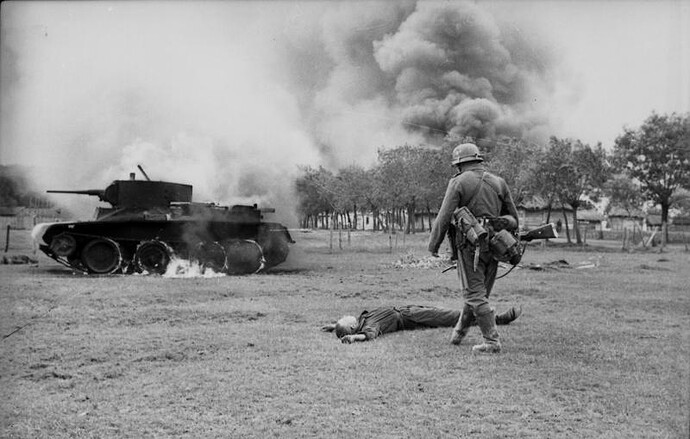The Battle of Brody: The Biggest Tank Battle Ever (And It’s Been Completely Forgotten)
Robert Beckhusen via The National Interest
March 20, 2017
A thousand coffee table books and countless hours of popular history programs have described the Battle of Prokhorovka, part of the Third Reich’s 1943 Operation Citadel, as the largest tank battle in history. Near the city of Kursk on the Eastern Front, hundreds of Soviet tanks slammed into the 2nd SS Panzer Corps in an enormous conflagration of flesh and metal.
Prokhorovka was certainly an important clash and one of the largest tank battles ever, but it might be time to retire its description as the biggest — a claim which has been seriously questioned in recent years by historians with access to Soviet archives opened since the end of the Cold War.
In fact, there’s a strong case that history’s largest tank battle actually took place two years prior and is largely unknown.
Prokhorovka was the centerpiece of Citadel, the last German strategic offensive on the Eastern Front. On July 12, 1943, counter-attacking Soviet tanks charged across open terrain, taking heavy losses to German tank fire, including from heavily-armored Tiger Is with 88-millimeter guns.
This particular engagement was a tactical defeat for the Soviets, but the charge inflicted enough damage to help stall — and eventually halt — the German army’s Citadel offensive.
So, how many tanks were at Prokhorovka? To be sure, not the common popular figures which range as high as 1,500 tanks in total, according to the 2011 book Demolishing the Myth: The Tank Battle at Prokhorovka, Kursk, July 1943 by Valeriy Zamulin, a Russian military historian and former staff member at the Prokhorovka State Battlefield Museum.
The actual number was 978 tanks in total — 306 German and 672 Soviet, according to Zamulin. As many as 400 Soviet and 80 German tanks were destroyed.
Expanding the battle beyond Prokhorovka, the total number of tanks fielded by the 2nd SS Panzer Corps and the Soviet 5th Guards Tank Army at and near the battle amounted to 1,299, according to a statistical analysis published in 2000 by Niklas Zetterling and Anders Frankson.
Expanding the number to encompass all of Operation Citadel would include many more tanks. But they were not concentrated and committed in the same numbers as at the Battle of Brody, which hardly anyone has written about.
That’s also according to Zamulin and David Glantz, a historian of the Eastern Front and Soviet military. “This, in fact, is the biggest tank battle in World War II,” Glantz said regarding the Battle of Brody during a 2007 lecture available via the U.S. Army Heritage and Education Center.
Nazi Germany invaded the Soviet Union on June 22, 1941. Beginning on June 23 between Dubno, Lutsk and Brody in far western Ukraine, six Soviet mechanized corps under Gen. Mikhail Kirponos launched a counter attack into the advancing 1st Panzer Group advancing toward Kiev.
The battle which developed and then concluded on June 30 was a confusing morass that swallowed 2,648 Soviet tanks out of a total force of 5,000 versus some 1,000 German tanks. It’s unclear how many tanks of the 1st Panzer Group were destroyed in the battle, but the force did lose 100 of its tanks during the first two weeks of the war.
Making sense of the chaotic battle on available maps is … difficult. The six Soviet corps were disorganized and lacked enough trucks and tractors to transport infantry, howitzers and supplies, and their attacks were uncoordinated. German warplanes bombed them incessantly, and fast-moving Panzer divisions with coordinated artillery support chopped them apart.
What’s all the more remarkable is that the Soviet corps had considerable numbers of heavier KV and T-34 tanks, tougher than the German army’s best tanks at the time.
The Soviet 10th Tank Division of the 15th Mechanized Corps alone had 63 KVs and 38 T-34s, according to Glantz’s book The Initial Period of War on the Eastern Front. However, lightly-armed BT and T-26 tanks comprised the bulk of the Soviet force.
By June 29, 1941, as the advancing German tanks encircled and annihilated the Soviet units, with others falling back, “the battles the Soviets were still waging elsewhere were now battles more for survival than anything else,” Glantz wrote, “because at this point the Soviets began running out of fuel and ammunition.”
There were some limited Soviet successes. When the 13th Panzer Division advanced on Rovno, Gen. Konstantin Rokossovsky of the 9th Mechanized Corps — who would become one of the USSR’s most famous commanders — bombarded it with artillery and inflicted a heavy loss of life. Rokossovsky had actually set up the ambush after ignoring an order to continue counter-attacking, deeming it pointless.
Glantz also noted in When Titans Clashed: How the Red Army Stopped Hitler that the battle contributed in a small way to Germany’s later defeat on the Eastern Front by drawing away German troops intended for the advance on Moscow.
The USSR went on to inflict a major defeat on Germany during the Moscow counter-offensive during the winter of 1941–1942, closing the door on the Germans ending the war on the terms Hitler set out. The later Battle of Stalingrad in 1942–1943 ended the possibility of German victory completely.
“The southwestern border battles also demonstrated that German armor was not invincible, and they gave future commanders such as Rokossovsky their first expensive but useful lessons in mechanized warfare,” Glantz wrote.
But it was at a terrible cost.
This first appeared in WarIsBoring



 LOL No, it seems that the people at Photobucket will no longer allow free hosting and you have to pay which I will not do!
LOL No, it seems that the people at Photobucket will no longer allow free hosting and you have to pay which I will not do!